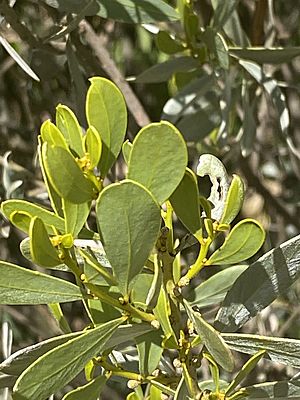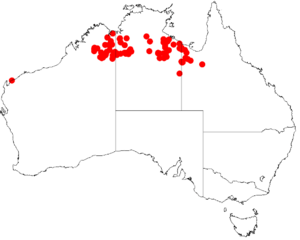Acacia argyraea facts for kids
Quick facts for kids Acacia argyraea |
|
|---|---|
 |
|
| Scientific classification | |
| Genus: |
Acacia
|
| Species: |
argyraea
|
 |
|
| Occurrence data from AVH | |
The Acacia argyraea is a type of shrub. It belongs to the Acacia family, also known as wattles. This plant grows naturally only in the warm, tropical areas of northern Australia. When a plant or animal is found only in one specific place, it is called endemic.
Contents
About the Silvery Wattle Plant
This plant is often called the silvery wattle. It is a shrub that usually grows between 0.8 and 3 meters (about 2.6 to 9.8 feet) tall. Its bark is smooth and can be grey or brown. The branches have two or three angles and are covered in soft, silky hairs.
What are Phyllodes?
Like many Acacia species, Acacia argyraea does not have true leaves. Instead, it has special flattened stems called phyllodes. These phyllodes look and act like leaves. They are always green and have a narrow, oval shape. Each phyllode is usually 4 to 8 centimeters (about 1.6 to 3.1 inches) long. They are also 15 to 35 millimeters (about 0.6 to 1.4 inches) wide. You can see three to six clear lines, or nerves, running along the surface of each phyllode.
When Does it Bloom?
The Acacia argyraea produces bright yellow flowers. These flowers usually appear between April and July.
Where the Silvery Wattle Grows
The Acacia argyraea is found in several parts of northern Australia. It grows in the Kimberley region of Western Australia. You can also find it in the Northern Territory. In Queensland, it grows in the northwest, generally north of 20° latitude. However, it is not very common in Queensland.
What Kind of Soil Does it Like?
This shrub often grows in areas with shale rock. Shale is a type of soft rock that splits easily. It can also grow in other kinds of soil. These include lateritic soils, which are rich in iron, and sandy soils.

